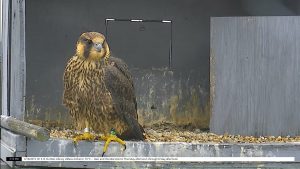About Falcons
2 Appearance
Lauren Weiss
Peregrine falcons are medium-sized falcons. They exhibit a trait called sexual dimorphism, which means that there is a difference in size or physical appearance between male and female falcons. With peregrine falcons, the difference between them is their size. Male falcons are approximately one-third smaller than female falcons. That is why they are sometimes called tiercels, which is an old word meaning “third.”

Male falcons are approximately 15-18 inches long, slightly smaller than a crow, with a wingspan of 35-42 inches. Female falcons are approximately 18-20 inches long, slightly larger than a crow, with a wingspan of 42-48 inches. Peregrines weigh between 18.7-56.4 oz (530-1600 g), which is approximately 1-3 lbs .

Female falcons are larger than male falcons because their larger size offers them more protection. Also, it is easier for a small, fast male to provide for his family because small, fast prey is often more abundant than large, slow prey.
Adult peregrine falcons have bluish-gray to slate-gray backsides with a buffy white underside speckled with black. They have black crowns, or tops of their heads, and black malar stripes down their face like sideburns. These “sideburns” act like the black stripes that athletes paint under their eyes to help reduce glare from the sun so they can see better.
They also have a white throat and a dark bill with a prominent yellow fleshy base called a cere. The upper beak is called the maxilla, which is curved and hook-tipped. The lower beak is called the lower mandible, which is shorter than the maxilla; the hook tip goes right over it. The maxilla also has tomial teeth, which are sharp points that fit into corresponding notches on the lower mandible when the falcon closes its beak. These allow the falcons to have a very strong bite.
Falcons have yellow legs and feet, as well as sharp curved claws called talons. Falcons have 3 toes in front and one in back called a hallux. A falcon’s toes are long and help it strike and grab. It can curl its talons into “fists” to knock small prey out of the sky and then carry it back to the nest. Other birds of prey have short, stronger toes so they can hunt larger animals without breaking a foot.

Immature, or juvenile, peregrine falcons are young falcons that have not gone through their first molt yet. Molting is when a bird loses its old feathers and grows new ones to replace them. Before they molt, immature falcons have brown backsides and heavily streaked, or speckled, undersides. This coloring allows immature falcons to pass through adult falcons’ territories without being considered a threat.

Media Attributions
- Adult Male Falcon is licensed under a CC BY (Attribution) license
- Adult Female Peregrine is licensed under a CC BY (Attribution) license
- Juvenile Falcon © UMass Amherst Libraries is licensed under a CC BY (Attribution) license
- Peregrine Falcon Anatomy (1) © Lauren Weiss; Chick Photo Credit: Samm Smith is licensed under a CC BY (Attribution) license

